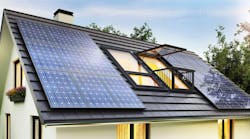What’s the Difference Between Silicon Solar Panels and Emerging Solar-Cell Tech?
What you’ll learn:
- What crystalline-Si solar panels can do, and what they can’t.
- How emerging third-generation solar cells compare with c-Si.
- How emerging third-generation solar cells could improve current c-Si solar panels.
In recent decades, investment and research into renewable energy has skyrocketed as governments and industries try to meet low carbon-emission targets. Solar panels, or photovoltaics (PV), have emerged as key players in addressing the energy crisis, drawing significant attention. Last year, global investment in solar-panel technology surpassed that of all other renewable-energy sources combined.
One key reason for this growth is that solar energy is abundant, reliable, and free. The sun provides an immense amount of energy—just 90 minutes of sunlight is enough to meet global energy demand for an entire year. While solar panels are limited by a fundamental efficiency limit of ~34%, this still allows us to harness up to 330 W/m² of energy, making it a significant and valuable resource.
In addition, the versatility of solar panels means they can:
- Be integrated into larger grid systems and used alongside other renewable-energy technologies.
- Be used in smaller standalone systems for smaller electronics and IoT devices.
- Be used to power individual communities in regions without the large-scale infrastructure needed for a grid-based power system.
The Rise of Crystalline-Silicon PV
Currently, the solar-panel landscape is dominated by crystalline-silicon (c-Si) technology. Silicon is a well-known and well-used semiconductor, largely due to its abundance and its ability to absorb visible light. Therefore, it was one of the first solar-cell technologies to be commercially developed.
Extensive research has focused on developing and improving the efficiency and manufacturing processes of silicon solar cells.
In 1978, the most efficient c-Si solar cells could achieve roughly ~13% efficiency. Since then, this has more than doubled with the highest efficiency c-Si devices achieving 26.1% as of 2023 (up to 27.6% with a solar concentrator, a system of curved mirrors or lenses which redirects sunlight onto the solar cell). C-Si solar panels are approaching their theoretical maximum efficiency of 29.43% (with a concentrator), while mass-produced c-Si solar modules have an average efficiency of 15% to 23%.
Silicon solar cells are robust, durable, and retain performance over decades, making them a strong market leader. In the past few years, significant global investment has focused on scaling PV production, particularly in China. As a result, the price of silicon PV modules has dropped dramatically—from $0.80 per watt in 2014 to $0.37 by 2023. This price reduction has made silicon PV more accessible, leading to 5.7 GW of new PV installations in the U.S. alone during early 2023.
Issues with Crystalline-Silicon PV
One of the main challenges with c-Si solar cells is the inherent limitations of silicon itself. Though it’s a semiconductor, silicon has an indirect bandgap, meaning it doesn't absorb light as efficiently as other materials. To achieve efficient PV devices, a thick layer of silicon is required, making these solar panels rigid, heavy, and opaque. Moreover, silicon devices must be encapsulated in ethylene vinyl acetate (EVA) and glass layers, further contributing to their weight and rigidity (Fig. 1).
Sometimes, this isn’t an issue: New buildings are designed with solar-panel integration in mind, and many buildings can easily accommodate them. However, retrofitting rigid and heavy solar panels onto older structures poses a challenge. In addition, c-Si panels are somewhat restricted in terms of applications; they can’t be thin, flexible, or semi-transparent as well as high efficiency. This restricts how creatively and broadly c-Si panels can be deployed.
Also, while c-Si solar panel production costs have dropped significantly, it still requires a complex and energy-intensive process, and that means a huge startup cost and generation of considerable waste.
What About Third-Generation Photovoltaics?
Alongside silicon technologies, significant research focuses on alternative solar technologies. Second-generation photovoltaics, like CIGS, CdTe, and a-Si, are promising, but they face challenges due to production complexities and material scarcity. Over the past 15 years, a new generation of PV has emerged aiming to surpass efficiency limits, reduce production costs, and broaden the potential applications of solar technology.
Third-generation PVs utilize new materials, such as organic semiconductors, quantum dots, and perovskites, to harness solar energy more effectively. These also provide greater versatility, with applications ranging from flexible solar panels to tandem structures that capture the full solar spectrum. These innovations are vital for discovering more sustainable and creative solar-energy solutions (Fig. 2).
One of the most successful third-generation technologies is the perovskite solar cell (PSC). PSCs combine organic and inorganic materials in a unique crystal structure (ABX3), allowing for easy customization by altering the molecular composition. This tunability enables the design of highly efficient solar cells rivaling silicon, with a record 26.7% efficiency achieved in 2024 (Fig. 3).
Another example is the organic solar cell (OSC). Organic solar cells use a combination of organic materials within a single layer to absorb light, converting this into extractable current. Like perovskites, OSCs use a wide range of materials to optimize performance. After a period of stagnation, OSCs have made significant strides, achieving an efficiency of 19.2% in recent years.
Other types of third-generation photovoltaics include quantum-dot solar cells and dye-sensitized solar cells (DSSCs). Quantum-dot solar cells use nanoscale semiconductor particles to absorb light in a thin film. DSSCs, meanwhile, rely on a dye to absorb sunlight, providing a low-cost and semi-transparent solution for solar energy.
A major advantage of these emerging technologies is their compatibility with roll-to-roll (R2R) manufacturing processes, such as ink-jet printing, slot-die coating, or spray coating. The ability to print or coat photovoltaic layers onto flexible substrates in continuous R2R production enables large-scale production with less waste. Lowering manufacturing costs will increase the opportunities for adoption in commercial settings.
Unlike silicon-based solar panels, which require energy-intensive, high-temperature processing steps, some third-generation PVs can be solution-processed at lower temperatures. However, more sensitive materials may require controlled environments, like a glove box to prevent degradation during fabrication.
Another key benefit of third-generation photovoltaics is that due to their variable composition, they’re able to be optimized to absorb light more efficiently than silicon. This means thin layers of these materials can still achieve highly efficient energy conversion. Therefore, these technologies can be used in applications where traditional silicon panels would be unsuitable, for example:
- Semi-transparent photovoltaics for windows
- Flexible solar panels for curved or irregular surfaces
- Indoor photovoltaics that can operate under artificial light
These innovations open up a wide range of possibilities for solar-energy integration in spaces and applications that were previously limited by the rigidity and thickness of c-Si panels.
Silicon PV vs. Third-Generation PV
For an emerging solar-panel technology to compete with silicon, it must be as good as or better than silicon. Namely, it must:
- Offer comparable or superior efficiency in converting sunlight into electricity.
- Demonstrate long-term stability, maintaining at least 90% of its performance over a 10- to 25-year lifespan.
Currently, no third-generation PV technology can address both of these points.
Most third generation PVs have significant stability issues that need to be overcome before they are to compete with c-Si panels. OPVs, DSSCs, quantum dots and PSCs demonstrate degradation due to external factors such as moisture, oxygen, UV light and heat, preventing them from being a viable competitor for silicon. DSSCs and quantum dot solar cells also suffer from low efficiency compared to silicon.
Perovskite solar cells have the additional issue of toxicity, as they use lead as a main component. Current research is ongoing to find replacements for lead, but these devices are significantly lower efficiency.
However, with significant research and proper encapsulation techniques, there’s definitely space for both c-Si and third-generation technology in the solar landscape.
Can Third-Generation PV Improve Current Solar Panels?
Another exciting quality about third-generation PV technologies is that they can be used in tandem with one another or combined with silicon in tandem solar panels to further enhance efficiency (Fig. 4). By stacking PSCs on top of silicon solar cells, the resulting tandem solar panel can capture a broader range of the solar spectrum, boosting overall efficiency.
As of 2024, the highest reported efficiency for perovskite-silicon tandem solar cells stands at 32.5%. This demonstrates their potential to enhance the existing silicon infrastructure. These hybrid systems represent an exciting pathway for improving the performance of current PV installations without the need for an entirely new technique.
References
“Summary for Policymakers. In: Global warming of 1.5°C,” IPCC (2018).
“The Use of Solar Power in Developing Countries,” Healing Waters International.
Razzaq, A. et al. (2022), “Silicon heterojunction solar cells: Techno-Economic Assessment and Opportunities,” Joule, 6(3), pp. 514–542.
D. Feldman et al. (2023), “Summer 2023 Solar Industry Update,” NREL.
About the Author

Mary O'Kane
Application Scientist, Ossila Ltd.
Mary O’Kane holds a PhD in perovskite solar cells, with a specialization in device engineering and precursor chemistry. As an Application Scientist at Ossila, she is responsible for developing, sourcing, and reviewing resources that help customers unlock the full potential of the company’s tools and materials. Ossila is dedicated to breaking down barriers in research by providing accessible, high-performance tools, quality materials, and reliable, practical resources.





